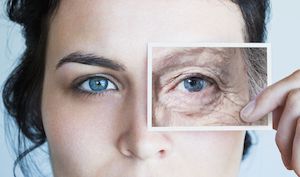Written by Jeff Smith
February is Age-Related Macular Degeneration month. We feel that it is important to bring awareness to this disease during this month and all months that follow because, like many age-related diseases, early detection is crucial to lessening symptoms and even preventing the disease itself. If you or someone you know suffers from AMD, it is important to be aware of any changes in your vision, and be proactive with regular trips to your eye doctor.
What is Age-Related Macular Degeneration?
Commonly referred to as AMD, age-related macular degeneration is a disease in the retinas of the eyes that affects more than 10 million Americans, and it is by far the most common cause of blindness in adults over the age of 55. AMD begins with blurred vision and progresses over time, with the blind spot eventually spreading to the rest of a person’s vision, causing total blindness.
AMD is primarily caused by genetics - researchers have found several genes with direct links to causing AMD. This has led to major breakthroughs in easing the symptoms created by the disease. Other risk factors include diet, smoking, too much bright light, cardiovascular disease, and hypertension.
Dry AMD
90% of all AMD cases are classified as dry AMD, thankfully it is the milder form of the two possibilities. Dry AMD is caused by a buildup of protein and fat deposits underneath the retina, it is nearly impossible to detect aside from following the trends in your vision loss over a long period of time. Dry AMD doesn’t usually cause total vision loss, but it will make an individual’s vision noticeably worse, and could eventually lead to wet AMD.
Wet AMD
Wet AMD accounts for the other 10% of AMD cases. When suffering from wet AMD, an individual’s retina is flooded with blood and fluid from abnormal blood vessels - hence the title “wet” AMD. If dry AMD is ignored, wet AMD is often the result. Wet AMD progresses very quickly and can cause substantial and permanent vision loss if not treated in a timely manner.
Early Symptoms
The first obvious symptom of AMD is blurred vision when attempting to focus. You may notice that your peripheral vision is still perfect, but objects you are attempting to focus on directly are blurry. If your entire field of vision is blurry, you may be suffering from a number of other issues, including Glaucoma, but you should still get checked for AMD.
As AMD develops, straight lines may appear to warp or distort. A good way to test if this is happening to you is to look at a piece of wide ruled notebook paper. If the lines don’t look entirely straight, you may be showing early signs of AMD. Over time, the blurriness will began to give way to true blind spots in your vision, and after complete loss of central vision, the rest of your vision will likely follow. It is also common that if one eye is showing symptoms, the other eye is likely to follow.
Treating AMD
AMD is one of the most well-studied ocular diseases, which has led to some groundbreaking treatments that can help to prevent and reverse some of the damage caused by this terrible disease. While reversing total blindness is beyond the scope of any existing treatments, early detection and treatment of AMD can often result in extremely positive results. The most common treatments involve regular ocular injections to halt the growth of blood vessels that commonly cause AMD. However, medications like the AREDS Formulation, EYLEA, Lucentis, and Avastin are growing increasingly popular as preventatives and symptom relievers.
Realistically, the most important aspect of avoiding potential vision loss related to AMD is to stay proactive. Like most age-related health issues, avoiding the problem altogether or catching it early can result in little to no long-term damage. The rule of thumb is that any time you feel your vision is shifting, make a visit your eye doctor.


